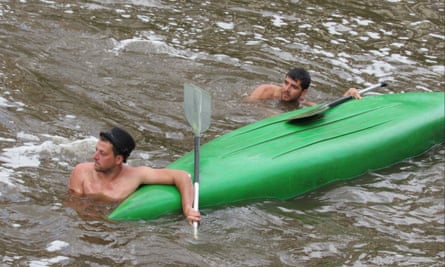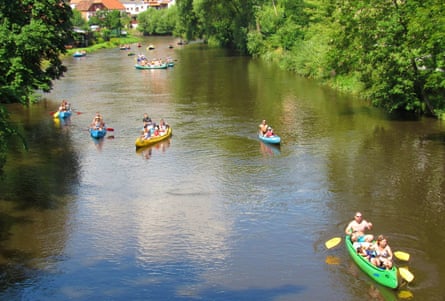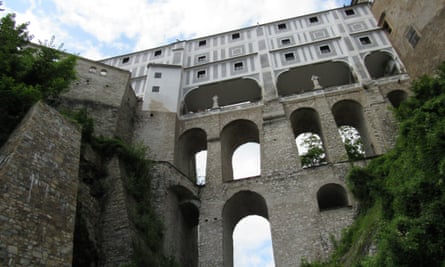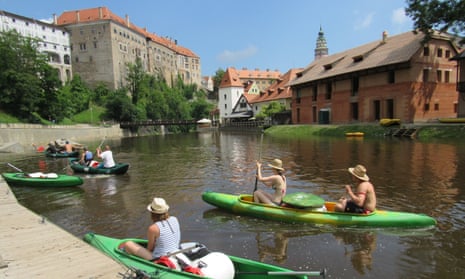‘Don’t hold the sides of the boat, make sure the barrels are firmly tied, and don’t get too drunk.”
This was the advice given by my Czech wife just before I set out for my Bohemian canoe trip – advice I remember only as I stand waist-deep in the water, tipsily grappling with an upturned canoe, and watching our belongings disappear down the river.
It is my maiden foray into Czech waters, and my first time in a canoe. My companion, Lukaš, is Czech and more athletic than me but also, I realise, hasn’t got the foggiest clue.
We are canoeing up the Vltava, a colossal waterway that snakes its way from the forests of southern Bohemia and through Prague before merging with the Elbe in the north. The river bursts into life in the summer, its waters awash with blue-and-white striped sailors in canoes, kayaks and rafts.

Our particular stretch is the favoured southern Bohemian part. Between Prague and the Austrian and German borders, it is laden with vast tracts of unspoilt woodland, innumerable fish ponds (where Czech Christmas carp has always been caught) and peppered with Renaissance chateaux.
And then there’s the final destination – Český Krumlov, 35km from our starting point at Vyšší Brod. This once-German stronghold is the jewel in southern Bohemia’s crown and the canoeing mecca of the Czech Republic. Every year, paddlers flock there in their thousands to have fun on the river, then a night out in the city.

At the riverside, we hire a Canadian-style canoe and two plastic barrels to store our gear in (ingetour.cz, £20 for two days). The rental guy warns us about the more dangerous weirs. “Place your more experienced paddler at the stern,” he says. “If you don’t, you’ll spend your entire trip in a yellow submarine!” (The dominant canoe colour is yellow.)
We float through the corridor of lush trees, Lukaš at the front and me at the back, making sure we don’t crash into ducklings. When we reach the first weir, we glide through it so smoothly, we even crack open a can of pilsner to celebrate.
The second one, however, poses a problem. Instead of a gentle, PG-rated dip, it is a long, X-rated water slide. Feeling gung-ho, we career down it, tins of lager casually wedged between our knees. Bad move. At the bottom, the boat sways, we both grab the sides, and the canoe capsizes theatrically. Our beers, our shoes, and, more distressingly, our barrels are gone.

We start calculating the value of the lost contents. But, mercifully, two kindly men have plucked the barrels out upstream. We buy them an ice-cream to show our gratitude, and they tell us how to tie the barrels to the canoe. Most canoeists, they also explain, get out and inspect each weir before deciding to tackle it. We decide on a different plan – get out and carry our canoe round all of them.
During the afternoon, the river is a marvel, a vibrant stream of craft laughing their way downstream, with passersby all greeting one another with an affectionate cry of “Ahoj”. On the water are friends, families, love-struck couples and old men with dogs. For most people, it’s a respite from city life – a sociable summer ritual.

“Canoeing is an amazing subculture,” says Ondřej Vach, who is doing the route with his wife and some mates. “Everyone is friendly and willing to help. And all canoeists drink!”
He isn’t joking. On most canoes, including his, bottles of tuzemak (rum made from sugar beet) dangle in the water to keep cool, and larger groups link their boats together, with the outside canoeists steering while the rest imbibe in the sun. Having lost our entire alcohol supply to the weir, we stop at a boat bar, a tiny raft anchored in the river, and refresh ourselves with two generous beakers of Cuba Libre.

At 6pm, we moor at the route’s halfway point, a campsite called Kemp Branná (tent and two people £6), which has modern showers, a playground and – for the authentic experience – a giant 15-man tipi. Around us, campfires blaze, špekáčky (chunky sausages) are barbecued and guitars strum Czech folk and Beatles songs.
The on-site bar is equally lively. While the chef operatically warbles the meal numbers, campers down shots of zelená – a Czech take on crème de menthe – and Becherovka – a Jagermeister-style digestif. After polishing off a hearty plate of halušky – gnocchi with bacon and sheep’s cheese – we sample one of each, then sensibly turn in: we’ve over 15km of Vlatva to do tomorrow.
We reach our destination the next morning, and it’s breathtaking. The river skirts Český Krumlov’s old castle walls, where locals line the banks, drinking espresso and watching the boats come in.
After tackling one last weir, we return our canoe to Ingetour’s rental shack and check into our rental apartment – a quaint wood-panelled place above the Muzeum Vltavinu (from £50 a night), then meander around Krumlov. One of the country’s most beautiful towns, it glistens in the sunshine.

Tiny streets burrow through the terracotta-and-white centre, with cute cafes providing shade from the midday heat. The castle – a gorgeous Unesco-listed site constructed between the 14th and 19th centuries – is a higgledy-piggledy complex perched on a crag. The gothic-turned-Renaissance fortress at the top is a marvel, and tucked within the castle’s baroque gardens is a revolving theatre.
